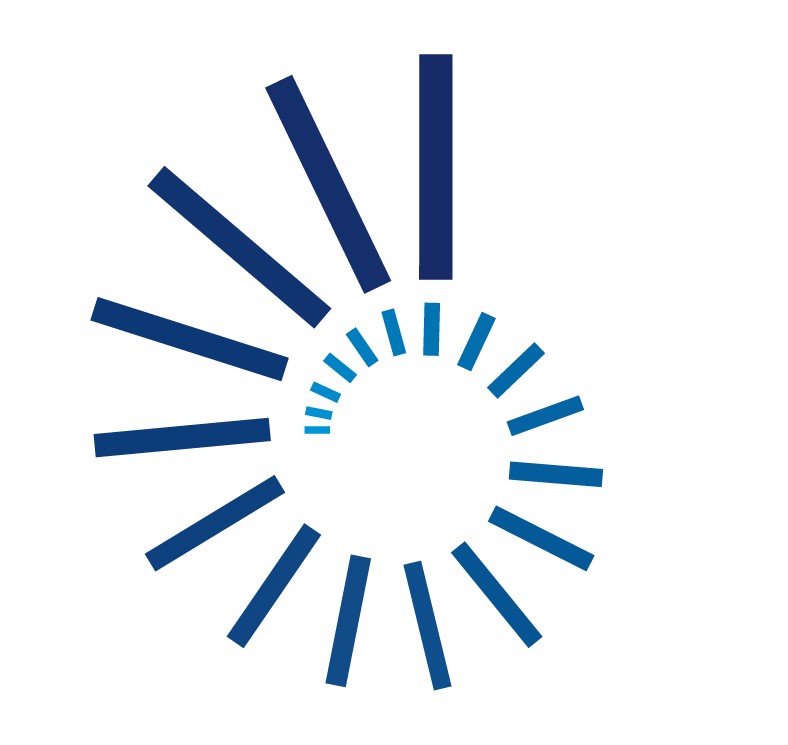Harmonisation
Technology Harmonisation provides all European actors with the framework and the key instruments needed to coordinate space technology at the European level.
This is achieved by identifying the needs and existing capabilities within Europe – as documented in Technology Harmonisation Dossiers – and by agreeing on ‘European Space Technology Roadmaps’, through a process of concertation, coordination and agreement between all participants. These joint Roadmaps aim at optimising public funding and guiding developments to ensure the right technology is at the right level of maturity at the right time.
The process has been developed to achieve better-coordinated research and development activities among actors in the European space sector, establishing a strong technology base as a means of underpinning the worldwide competitiveness of European industry and ensuring the success of future space missions.
Through nearly two decades of operation, and several major reviews that recommended its strengthening, Technology Harmonisation is now an established and well-proven European process. It involves over 1,000 European stakeholders, including ESA, national agencies and organisations, the European Commission, the European Defence Agency, and Space Entities (industry, R&D organisations, academia and associations).
In the scope of Harmonisation, space technologies are currently grouped into 48 topics, covering a wide range of subjects, from electric propulsion and de-orbiting technologies to optical communications and microelectronics. Topics are continuously evolving to recognise the dynamic nature of the space sector and emerging technology trends.
MAIN OBJECTIVES
"Fill strategic gaps" and "Minimise unnecessary duplications"
Consolidate European Strategic Capabilities
Achieve a Coordinated and Committed European Space technology Policy and Planning
Contribute to continuity and coherence between technology and industrial Policies
ESA TECHNOLOGY HARMONISATION ADVISORY GROUP - THAG
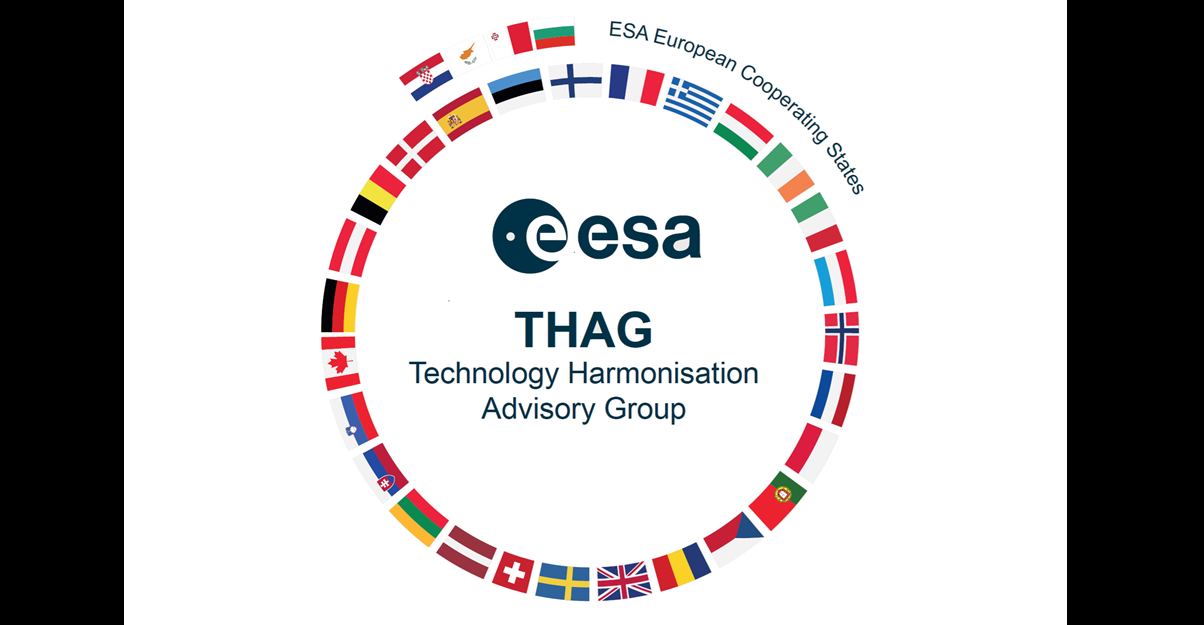
THAG is an ESA delegate body, established in 2006 to advise the ESA Industrial Policy Committee (IPC) on Technology Harmonisation matters, including:
- Technology harmonisation work plans
- Mapping of European capabilities with respect to the needs of the institutional and commercial markets
- Implementation within ESA programmes of agreed roadmaps and conclusions, and identification of national-and European-level funding
- Harmonisation measures to be applied in institutional programmes and by industry
HOW IT WORKS
ESA's Technology Coordination and Planning Office, supervises and coordinates all phases of the Harmonisation process to ensure European space technologies are aligned and strategically developed. Here's how the process works:
- Annual Topics: each year, up to 10 topics are selected for the Harmonisation. These topics are selected based on the last year of revisit, strategic needs and stakeholder input. They are reviewed and updated approximately every 4-5 years.
- Preparation of Dossier: ESA technical experts prepare Technology Harmonisation Dossiers (THDs) for each topic. These documents include strategic objectives, current capabilities and gaps, as well as future technology needs. They are shared with stakeholders via the Harmonisation our Harmonisation Document Management System (HDMS)
- Internal coordination: ESA ensures alignement across technical, strategc and programmatic areas. This guarantees that roadmaps are consistent with ESA's long-term pans and mission requierements.
- External Coordination: the European and Canadian space community participates through open onsultation rounds, held two times per year allowing stakeholders to review and comment on draft technology harmonisation dossiers including strategic roadmaps.
This process ensures coherence in technology developement across Europe, efficint use of resources by avoiding duplication, timely avilability of technologies for future missions.
How to participate
The European Space Technology Harmonisation is a voluntary process, based on transparency and exchange of information. Continuous support from all participants is crucial to the success of this European initiative.
European and Canadian Space Entities are invited to join Harmonisation including:
- Industry
- R&D Organisations and Academia
- Associations
Whether actively participating or not, the results are available to all stakeholders.
Space Entities may submit their inputs on the different technologies addressed during the consultation rounds through one of the channel listed below.
DIRECT PARTICIPATION
on ESA STAR Update your:
- Technology profile
- Entity capability responsible
You will be invited to participate to the consultation and harmonisation meeting when the topic corresponds to your entity capability areas of expertise
PARTICIPATION THROUGH THE NATIONAL DELEGATE
REMAIN IN CONTACT WITH YOUR NATIONAL DELEGATE
The THAG Delegat may recommend how to proceed further.
If you need the contact details of your THAG Delegate, please contact us

Access to Harmonisation Documentation
As a European or Canadian entity, you can request access to the harmonisation database on the Eclipse Polaris platform.
Harmonisation Process phases
Ongoing Harmonisation Cycles - topics and key dates
2026 Topics
Cycle 1 - Consultation Phase
Cycle 2
Actuators Building Blocks for Mechanisms
Ground Station Technology
Pyrotechnic Devices (within release mechanisms)
On-Board Computers, Data Handling Systems and Microelectronics
Printed Circuit Boards and Electronic Assembly Technologies
Avionics Embedded Systems
Additive Manufacturing
On-Board Software
Micro and Nano Technologies – MEMS Pressure Sensors, MOEMS and RF-MEMS
Radiation Environment and Effects
2026 Dates
Cycle 1
Cycle 1
Dec 2025
Feb 2026
Space Entities Consultation Start
17-19 Feb 2026
19-21 May 2026
Harmonisation Meeting
Jul 2026
Nov 2026
Dossiers Pubblication
2025 TOPICS
Cycle 1 - Published
Cycle 2 - Published
On-Board Radio Navigation Receivers
Power Management and Distribution
Critical Active RF Technologies
Power RF Measurements and Modelling
Enabling Artificial Intelligence for Space System Applications
Solar Array Drive Mechanisms
TT&C Transponders and Payload Data Transmitters
Solar Generators and Solar Cells
Functional Verification and Mission Operaions Systems
Harmonisation topics
Composite Materials
Last Harmonised in 2024
This topic covers all relevant families of composite materials for space applications, including fibre-reinforced thermoset (such as epoxy and cyanate ester) and thermoplastic (such as PEEK) composites, carbon-carbon composites, ceramic matrix composites, and metal matrix composites. The content of the topic is classified as listed below.
- Polymer Matrix Composites (PMCs): polymer-based resin (thermoset or thermoplastic) matrices reinforced with a variety of fibres (glass, carbon, aramid). These are the most widely used composite materials for space applications.
- Metal-Matrix Composites (MMCs): metal (e.g. aluminium, magnesium, titanium, copper, silver) matrices reinforced with fibres or particles that can resist the manufacturing process (e.g. silicon carbide or high melting-point metal).
- Ceramic Matrix Composites (CMCs): carbon (or graphite) matrices reinforced with carbon (or graphite) fibres. Mainly used in very demanding applications (high temperature environments, high stability).
For each of the categories above, various materials as well as manufacturing processes are discussed.
The Technology Harmonisation Dossier (THD) and Roadmap can be accessed via our Harmonisation Document Management System under the following links: THD LINK / Roadmap LINK
If you do not have an account yet, you may request one by sending an email to harmo@esa.int from a corporate email address providing business affiliation and position in the company.
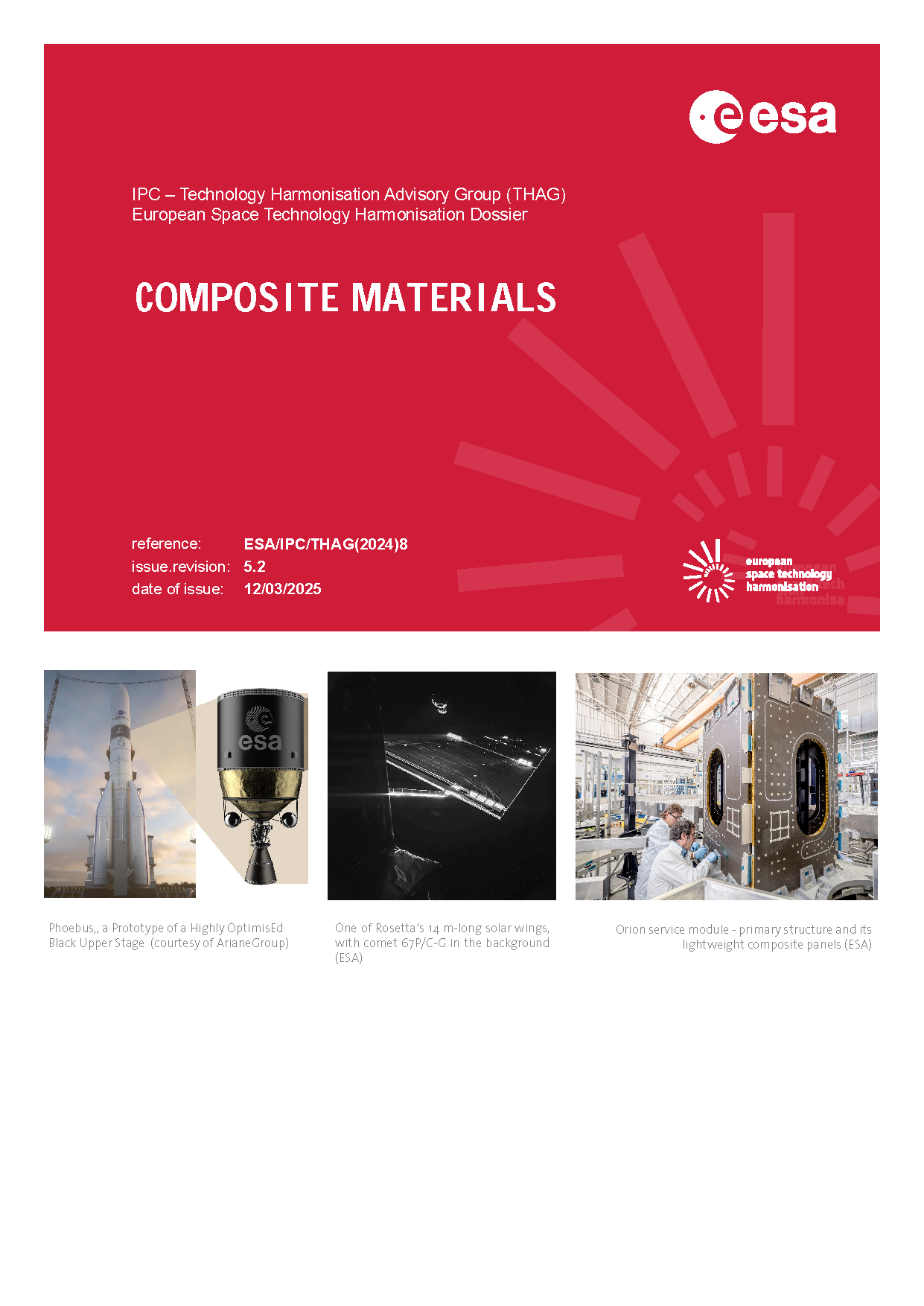
Critical Active RF Technologies
Last Harmonised in 2025.
This topic is focused on Gallium Nitride (GaN) and Silicon (Si) technologies for active RF devices employed in RF blocks such as amplifiers, frequency converters and modulators. The role of GaN is fostered in RF power amplification up to the 100-GHz range, whereas Si technologies, in particular RF CMOS and BiCMOS, are increasingly substituting traditional GaAs for RF circuits in certain low-power functions such as routing, conditioning, signal generation and frequency synthesis up to Ka-band.
The Technology Harmonisation Dossier (THD) and Roadmap can be accessed via our Harmonisation Document Management System under the following links: THD LINK / Roadmap LINK
If you do not have an account yet, you may request one by sending an email to harmo@esa.int from a corporate email address providing business affiliation and position in the company.
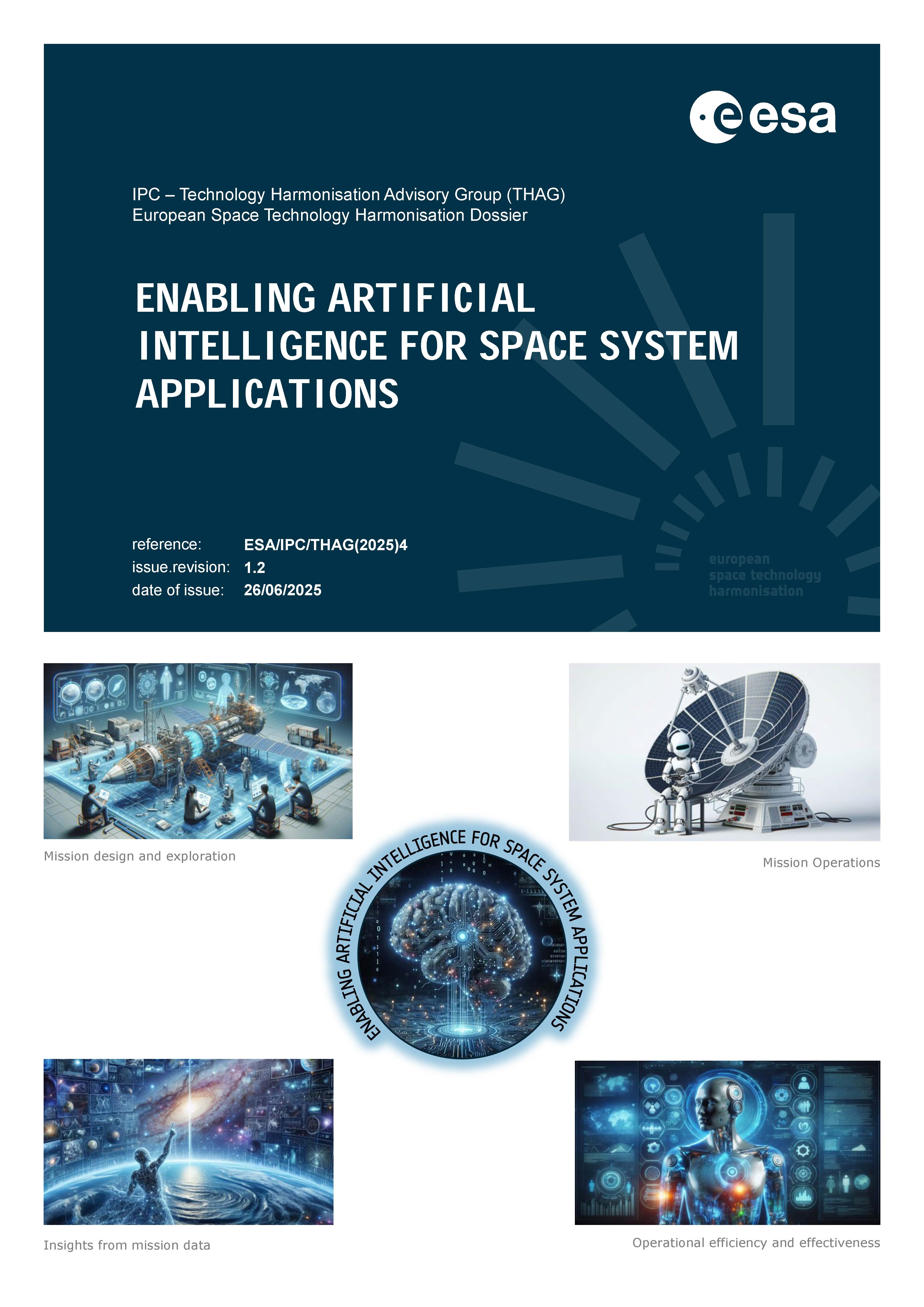
Cryogenics and Focal Plane Cooling
Currently in Harmonisation. Publication expected late 2024.
Cryogenics in general is the domain of thermal science dedicated to the study and the production of temperature below 200K (according to ECSS-E-ST-31C definition). Applied to the Space Sector, this term describes the different types of technologies that permit to reach and maintain such temperatures. The following technologies are covered:
- Radiators
- Thermoelectric coolers
- Cryostats
-Active cooling systems from 2K to 190K
- Stirling cooler
- Pulse Tube cooler
- Joule Thomson expansion cooler
- Solid Sate cooling (e.g. laser-coolers)
- Reverse Turbo-Brayton cooler
- Microcooling
- Sub-Kelvin cooler:
- Adiabatic Demagnetisation Refrigerators (ADR)
- Dilution Refrigerator
- 3He-sorption pump cooler
- Cooler drive electronics
- Cryogenic System Equipment: equipment required to integrate the above mentioned cooling systems with the detectors and the Spacecraft
- Cryogenic technologies for space transportation
- Cryogenic insulation solutions
- Propellant management
- Cold/Liquid Gas storage and transfer
- Cryogenics Heat Pipe and Loop Heat Pipes (for this one see the topic Heat Transport Equipment and Systems)
The Technology Harmonisation Dossier (THD) and Roadmap can be accessed via our Harmonisation Document Management System under the following links: THD LINK / Roadmap LINK
If you do not have an account yet, you may request one by sending an email to harmo@esa.int from a corporate email address providing business affiliation and position in the company.

Cubesat Propulsion
Last Harmonised in 2024
This topic addresses chemical, electric and advanced propulsion systems suitable for CubeSats of sizes up to 16U or 30kg of mass and capable of delivering thrust up to 0.5N. It covers:
- Chemical propulsion thrusters
- Cold Gas
- Mono-propellant
- Bi-propellant
- Solid propellant
- Hybrid propellant
- Water electrolysis
- Electrostatic: Atmospheric Breathing Electric Thruster (ABEP), Electron Cyclotron Resonance (ECR) thrusters, Electrospray thrusters, Field Emission Electric Propulsion (FEEPs), Gridded on Ion Engines (GIEs), Hall Effect Thrusters (HTs), High Efficiency MagnetoPlasmaDynamic Thrusters (HEMPTs)
- Electrothermal: Resistojet, Microwave Electrothermal Thrusters, Arcjets
- Electromagnetic: Pulsed Plasma Thrusters (PPTs), Vacuum Arc Thrusters (VATs), Helicon Plasma Thrusters including Ambipolar Thrusters, Electron Cyclotron Resonance Thrusters
- Other components: power and control electronics, power processing units, tanks, manifolds, feed systems, thruster pointing mechanisms, propulsion system modelling, test facilities, test diagnostics including thrust balances, propellants, GSE, pressure regulators, pressure transducers, mass flow sensors, mass flow controllers, temperature sensors, valves, filters, cathodes/neutralisers, harness and pipework.
Note that the coverage differs from that of Chemical Propulsion – Components (including Tanks) and Electric Propulsion Technologies principally in size, delivered thrust levels and approach adopted to qualification.
The Technology Harmonisation Dossier (THD) and Roadmap can be accessed via our Harmonisation Document Management System under the following links: THD LINK / Roadmap LINK
If you do not have an account yet, you may request one by sending an email to harmo@esa.int from a corporate email address providing business affiliation and position in the company.
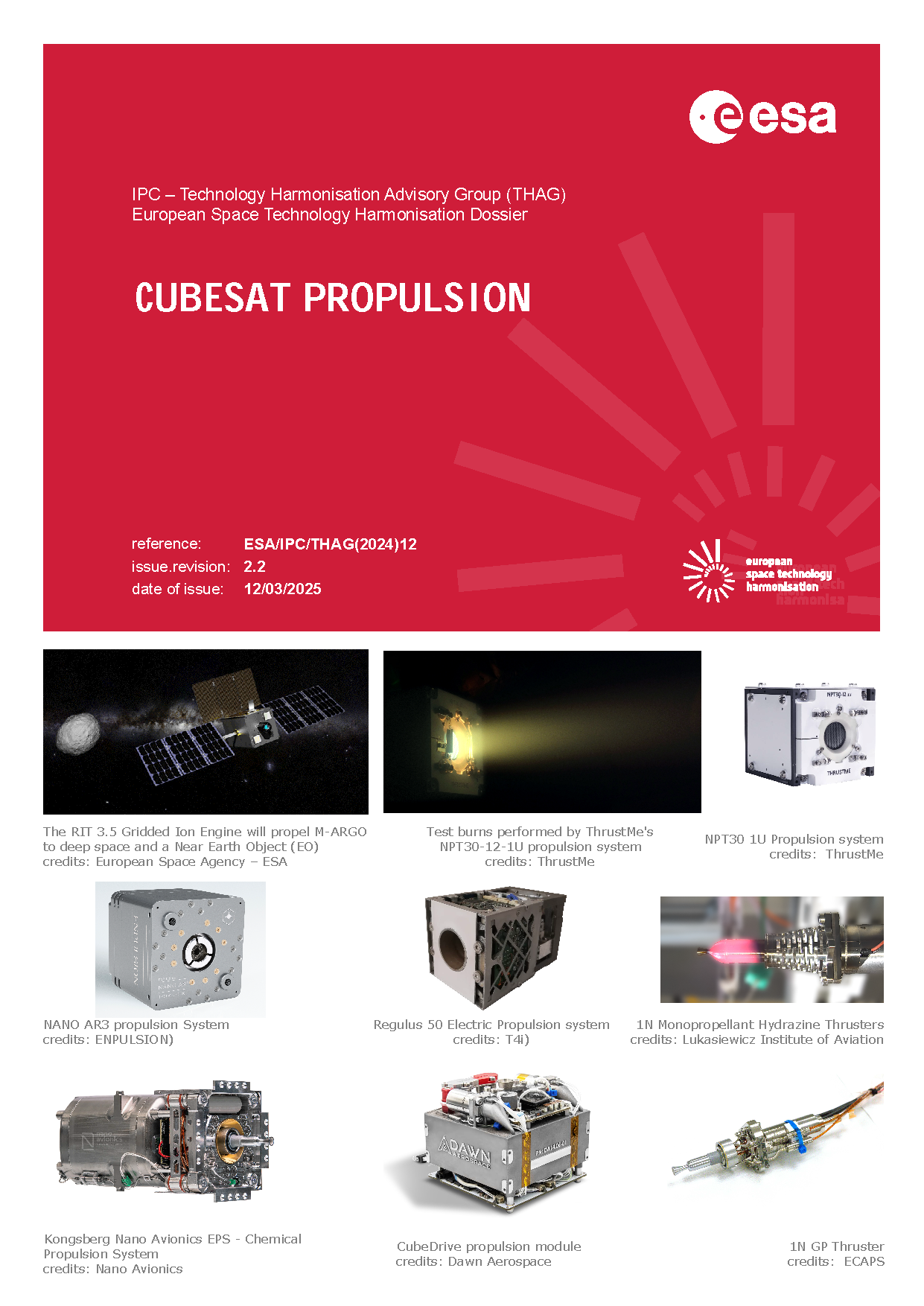
De-Orbiting Technologies
Last harmonised in 2023.
To limit the growth of space debris in an increasingly crowded space environment, new de-orbiting technologies and tools are required. These include technologies to passivate and dispose of the space segment, tools to model the reliability and compliance of such techniques, and solutions to ease the removal from orbit of spacecraft in case of failure. This topic covers technologies related to the areas listed below.
- De-orbit systems
- Passive de-orbit systems (e.g. drag augmentation devices, tethers)
- Active-de-orbit systems (controlled re-entry and semi-controlled re-entry)
- Autonomous de-orbit systems
- Passivation (power, propulsion)
- Reliability of disposal systems for de-orbiting and passivation
- Design for Demise (e.g. tanks, reaction wheels, magnetometers, early break-up and containment technologies)
- Design for Removal (mechanical capture interface, detumbling technologies, markers, retroreflectors)
- System-level integration and validation
Note that this topic is closely related with ESA’s Zero Debris approach and ESA’s Clean Space office activities.
The Technology Harmonisation Dossier (THD) and Roadmap can be accessed via our Harmonisation Document Management System under the following links: THD LINK / Roadmap LINK
If you do not have an account yet, you may request one by sending an email to harmo@esa.int from a corporate email address providing business affiliation and position in the company.
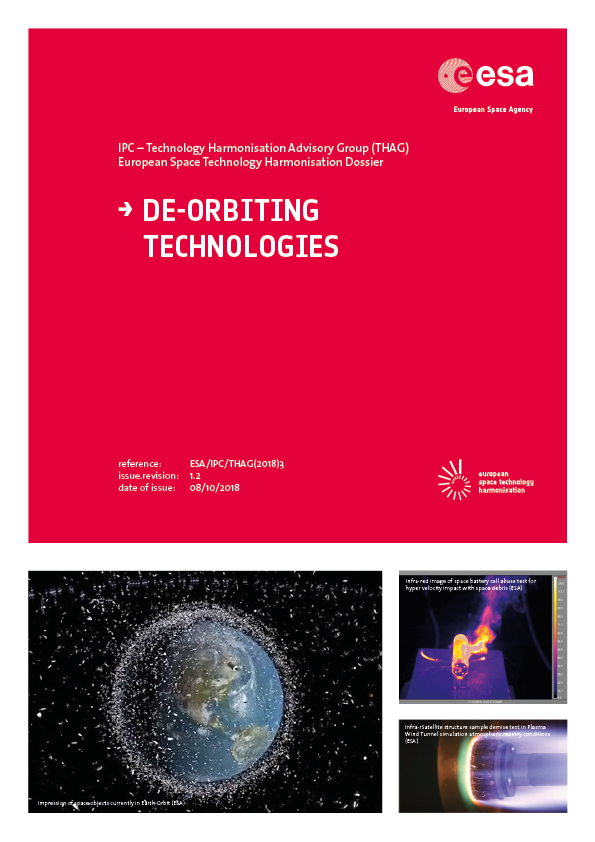
Deployable Booms & Inflatable Structures
Last harmonised in 2018.
Deployable boom technology (consisting of booms and masts) is typically associated with deployable, elongated structural members, where the cross section is by far smaller than the deployed length. These kinds of structures are stowed for launch and then deployed to their operational configuration. This topic covers all various technologies of the booms and masts., including multiple degree of freedom articulated long booms. Inflatable structure technology covers support/deployment structures for satellite appendages (beams, tori, reflectors, etc.), inflatable reflectors/antennas and inflatable re-entry bodies, habitats, airbags and balloons.
- Deployable booms
- Structural members
- Joints
- Synchronisation mechanisms
- Inflatable structures
- Inflatable element
- Inflation system
- Rigidisation system
- Launch containers
The Technology Harmonisation Dossier (THD) and Roadmap can be accessed via our Harmonisation Document Management System under the following links: THD LINK / Roadmap LINK
If you do not have an account yet, you may request one by sending an email to harmo@esa.int from a corporate email address providing business affiliation and position in the company.
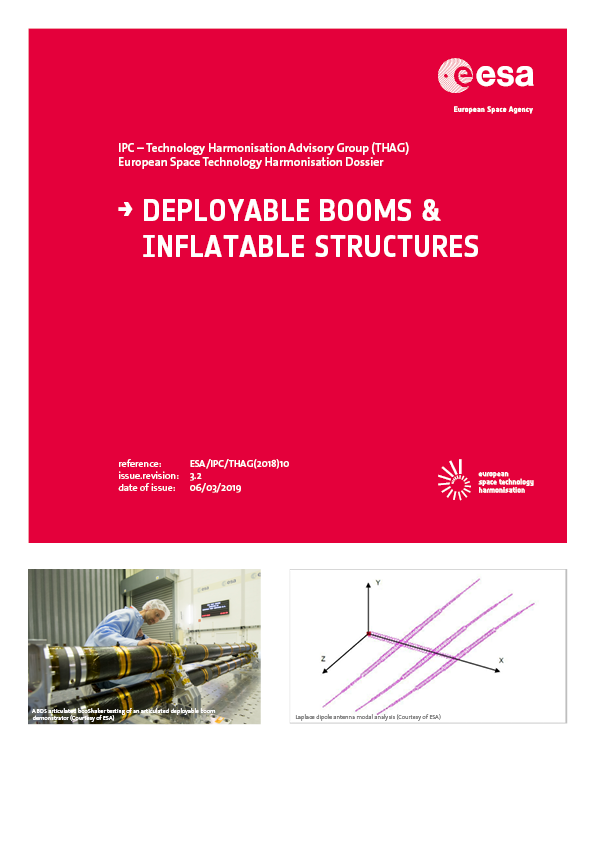
Electric Propulsion Technologies
Last harmonised in 2022.
Electric Propulsion uses electricity to accelerate a propellant and produce thrust. This topic covers the technologies for use in space listed below.
- EP thrusters
- Electrostatic: Electrospray Thrusters, Field Emission Electric Propulsion, Grided Ion Engines, Hall Effect Thrusters, High Efficiency Multistage Plasma Thrusters, Quad Confinement Thrusters
- Electrothermal: Arcjets, Resistojets, Microwave Electrothermal Thrusters
- Electromagnetic: Pulsed Plasma Thrusters, Vacuum Arc Thrusters, Magneto Plasma Dynamic Thrusters, Helicon Plasma Thrusters, Electron Cyclotron Resonance Thrusters
- Cathodes/Neutralisers
- Power Processing Units
- Flow Control Units
- Radio Frequency Generators
- Filters and valves
- Pressure regulators
- Pressure and temperature sensors
- Electric Propulsion Pointing Mechanisms
- Test facilities, Diagnostic Probes and Ground Support Equipment
- Thrust Balances
- Models and Codes
Note that Tanks are covered in Chemical Propulsion – Components (Tanks).
The Technology Harmonisation Dossier (THD) and Roadmap can be accessed via our Harmonisation Document Management System under the following links: THD LINK / Roadmap LINK
If you do not have an account yet, you may request one by sending an email to harmo@esa.int from a corporate email address providing business affiliation and position in the company.
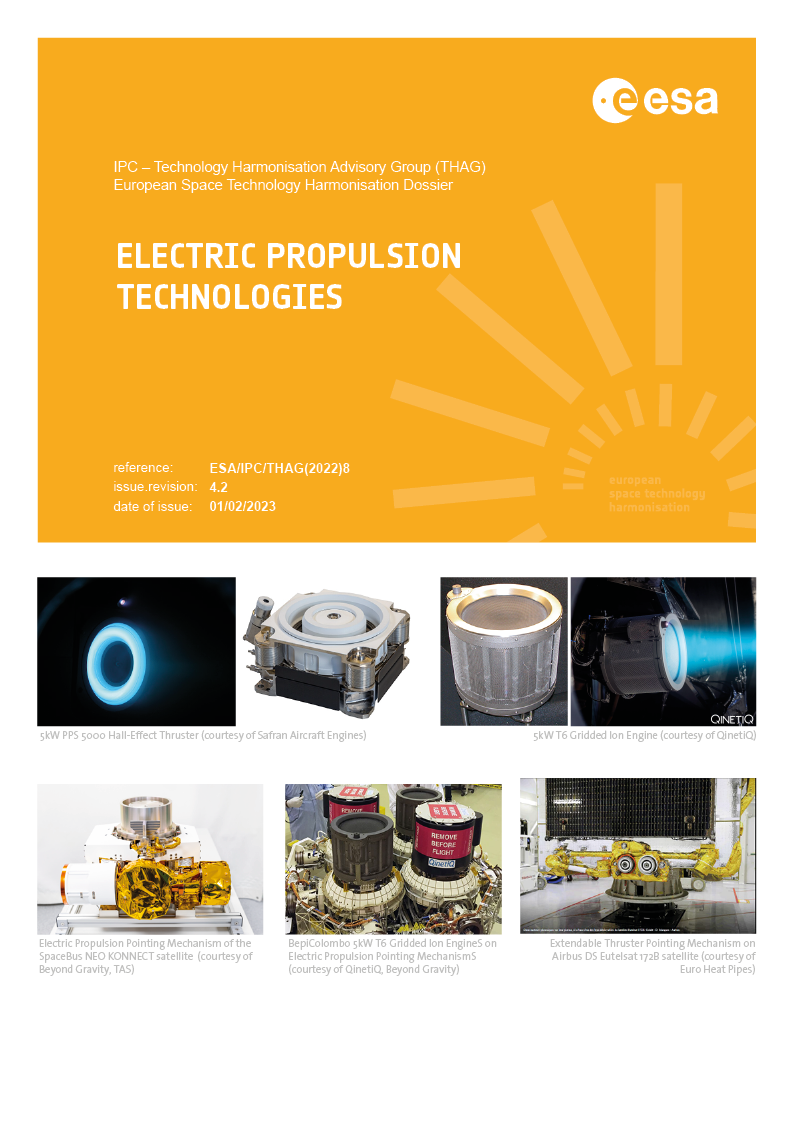
Electrochemical Energy Storage
Last Harmonised in 2024.
Energy Storage is a key part of almost every space mission, and is used to supply power during eclipse, to manage peak loads, and as a one-off (or contingency) source of electrical power.
Electrochemical energy storage is a subset of energy storage and it refers to technologies that store energy chemically to produce electrical power.
- Batteries: including primary batteries (non-rechargeable and thermal) and secondary, batteries (rechargeable)
- Regenerative fuel cell systems: including H2/O2 fuel cells and electrolysers, solid oxide fuel cell, and Co/CO2 fuel cells
- Supercapacitors: including Li ion capacitor
The Technology Harmonisation Dossier (THD) and Roadmap can be accessed via our Harmonisation Document Management System under the following links: THD LINK / Roadmap LINK
If you do not have an account yet, you may request one by sending an email to harmo@esa.int from a corporate email address providing business affiliation and position in the company.
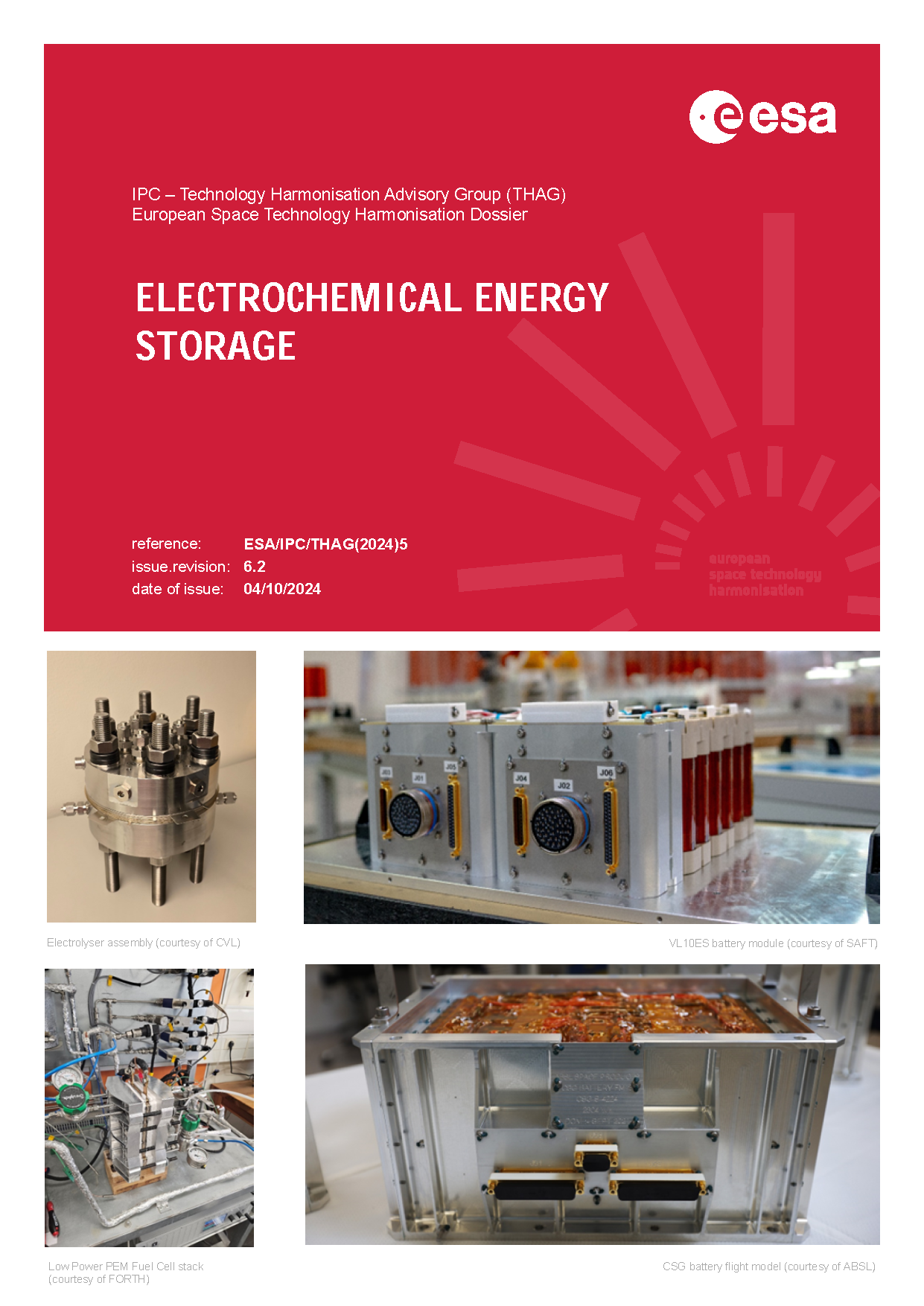
Electromagnetic Compatibility
Last Harmonised in 2024
Electromagnetic Compatibility (EMC) ensures that electrical equipment operates correctly in its environment without causing or experiencing interference. This is crucial for spacecraft, as EMC issues can lead to reduced performance or mission failure. EMC is not a technology as such, but in the context of harmonisation the EMC design, modelling and simulation tools, and test techniques are considered as technology.
-Design, modelling and simulation
- Design for electromagnetic cleanliness and compatibility
- Electrical harness design and technology,including connectors and cable assembiles
- Electromagnetic environment
- Developement of EMC models and simulation tools
- Test techniques
- EMC test and measurement techniques
- Magnetic test methods, magnetic modelling and simulation
- Non-standard test methods for highly demanding requirements (approach for large infrastructure, e.g. habitat modules)
The Technology Harmonisation Dossier (THD) and Roadmap can be accessed via our Harmonisation Document Management System under the following links: THD LINK / Roadmap LINK
If you do not have an account yet, you may request one by sending an email to harmo@esa.int from a corporate email address providing business affiliation and position in the company.
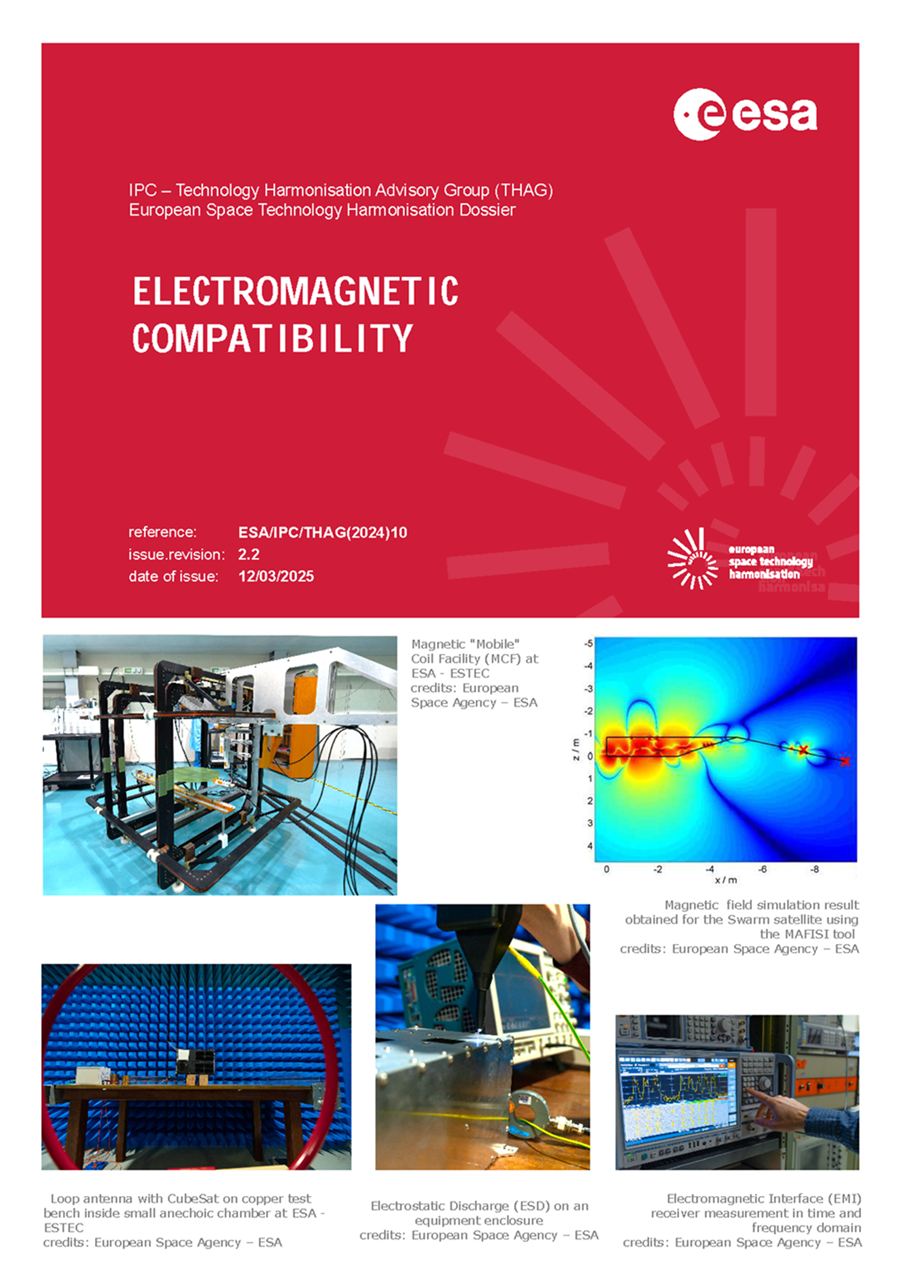
Technologies for Fluid Mechanics
Last Harmonised in 2024
Fluid mechanics is the discipline that studies the flow of fluids: liquids and gases. Space applications are related to ascent, descent, landing, aerobraking, aerocapture, and aerogravity assist.
The Dossier covers the following 5 main aresas
- Developing and Improving Fluid Mechanics Hardware
- Innovative aerodynamic surfaces (primary and complementary)
- Filling and refilling technologies for cryogenic and storable propellants to enable reusable propulsion system operating on ground and in-flight
- Fluid mechanics hardware and equipment for the management of liquids and gases including decelerators and advanced technologies for management of sounds and acoustics of space vehicles and innovative intake air collectors for air-breathing propulsion systems.
- Developing and Improving Fluid Mechanics Tools and Techniques
- Classical Computational Fluid Dynamics (CFD) tools: Euler, Navier-Stokes and direct simulation Monte Carlo codes and associated grid generation tools
- Advanced numerical methods: Large Eddy Simulation (LES) and Direct Numerical Simulation (DNS) for high-fidelity simulation of smaller-scale turbulent structures
- Physical models including thermochemistry, turbulence, transition, radiation, gas-surface interactions (oxidation, catalysis, ablation) and combustion
- Design tools: analytical, fast parametric design tools, optionally coupled with trajectory analysis tools. Aerodynamic (ATD) database generation
- Multi-disciplinary tools: informatic environment for coupling tools and databases of different technical disciplines; optimisation algorithms
- Plume impingement: interaction between thruster plume and spacecraft or ground surfaces
- Developing New Capabilities and Maintaining Ground Testing Facilities
- Ideal Gas Facilities: classical subsonic, transonic, supersonic, and hypersonic wind tunnels and corresponding intrusive and nonintrusive measurements techniques
- High Enthalpy Facilities: shock tubes, hot-shot wind tunnels, ballistic ranges
- Plasma Facilities: arcjets and plasmatrons
- Rocket Nozzle Test Stands: hot firings and jet interaction
- Decelerator facilities
- High Performance Computing (HPC) Systems
- Developing and Enhancing Sensors and Measurements Techniques
- In-flight measurements (intrusive and non-intrusive) such as Air Data Systems, intelligent measurement systems, and miniaturisation of flight measurement techniques.
- Developing Flight Demonstrators and Flight Data Analysis Tools
- Flight and ground demonstration missions and experimental vehicles to study critical phenomena in ATD; exploitation of data from flight experiments, specially involving ATD and (re-)entry.
The Technology Harmonisation Dossier (THD) and Roadmap can be accessed via our Harmonisation Document Management System under the following links: THD LINK / Roadmap LINK
If you do not have an account yet, you may request one by sending an email to harmo@esa.int from a corporate email address providing business affiliation and position in the company.
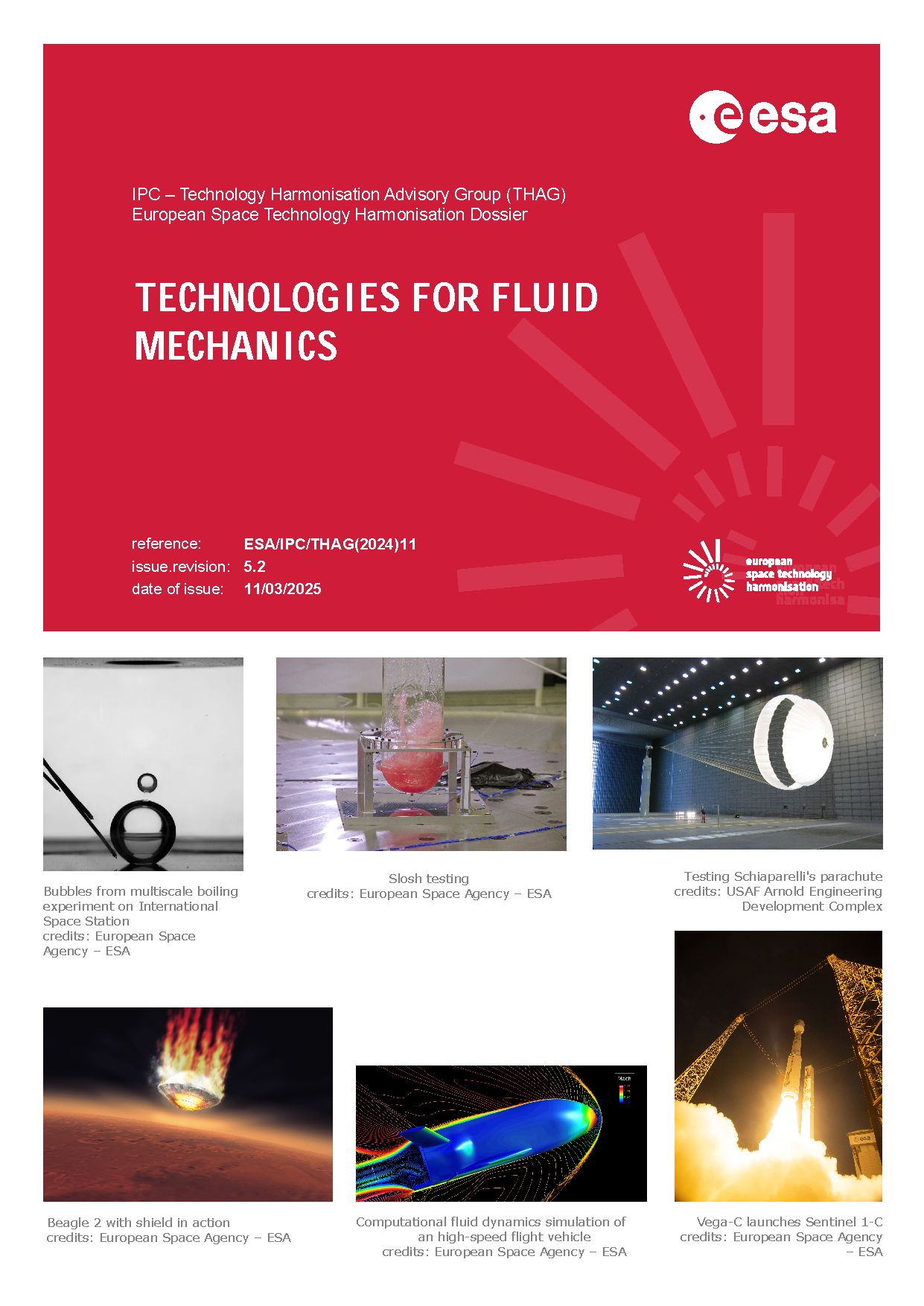
The European Space Technology Master Plan
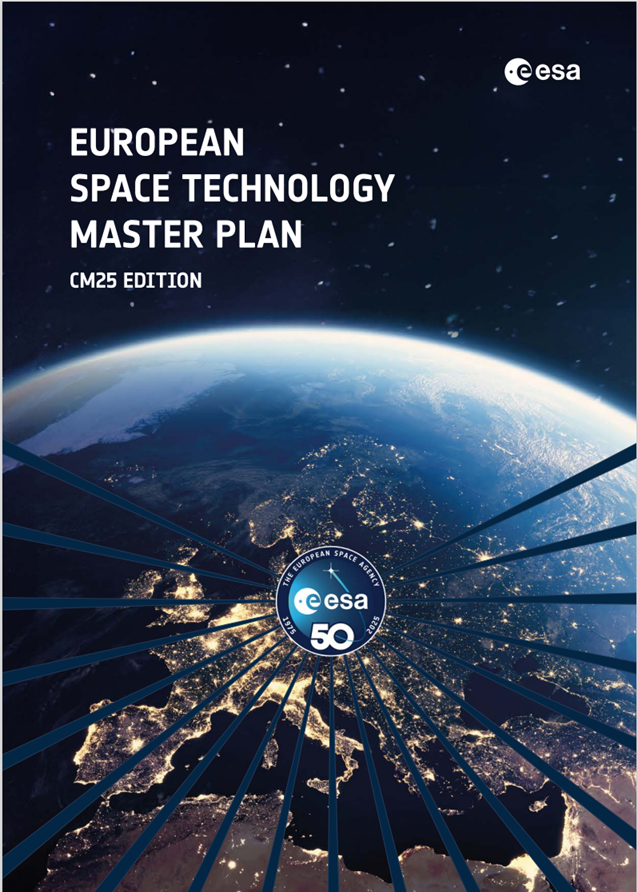
The European Space Technology Master Plan (ESTMP) 2025 provides a comprehensive overview of Europe’s strategic approach to space technology development. Published for the ESA Ministerial Council 2025, this edition CM25 marks both the 50th anniversary of ESA and 25 years of the European Space Technology Harmonisation process.
The CM25 ESTMP Edition gives an overview on:
- Space Technology R&D budgets in Europe in 2024
- The structure and objectives of the new Harmonisation process, involving ESA, national agencies, industry, academia, and associations
- ESA Technology Programme landscape
- The drive for European non-dependence in critical technologies
- ESA Council at Ministerial level – CM25: ESA’s long-term strategy and vision for 2040, outlining goals for innovation, sustainability, and competitiveness
The ESTMP serves as a reference for stakeholders across Europe, supporting informed decision-making and fostering collaboration to ensure Europe remains at the forefront of space technology
To access to the publication please contact us by email at estmp@esa.int from a corporate email address providing business affiliation and position in the company.



